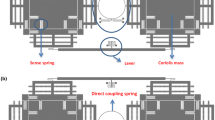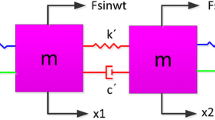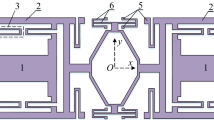Abstract
The frequency response of in-plane coupled resonators is used for investigating the acceleration sensitivity of a MEMS tuning fork gyroscope (TFG) and a new method of suppressing the acceleration output is presented. The unbalancing of two sense resonators in the TFG caused by fabrication errors converted an external vibration into anti-phase mode excitation. To reduce the acceleration output, decoupling between in- and anti-phase modal frequencies [decoupling ratio (DR)] is crucial, since coupled resonators may cause large anti-phase vibrations from the acceleration. The acceleration output model was verified using two coupled resonators with 1 and 5 % stiffness unbalance. FEM simulation results showed a 25 % reduction in the anti-phase vibration by increasing the decoupling ratio from 0.09 to 0.29, irrespective of the coupled resonators designs. Quantitative analysis of a TFG based on coupled resonators with 1 % stiffness unbalance showed the acceleration output decreased from 5.65 to 1.43 deg/s/g.








Similar content being viewed by others
References
Ayazi F (2011) Multi-DOF inertial MEMS: from gaming to dead reckoning. Proceedings Transducers’11, Beijing, China, pp 2805–2808
Bernstein J, Cho S, King AT, Kourepenis A, Maciel P, Weinberg M (1993) A micromachined comb-drive tuning fork rate gyroscope. Proceedings MEMS Conference, Fort Lauderdale, FL, pp 143–148
Cho J, Gregory JA, Najafi K (2011) Single-crystal-silicon vibratory cylindrical rate integrating gyroscope (CING). Proceedings Transducers’11, Beijing, China, pp 2813–2816
Geen JA (2004) Progress in integrated gyroscopes. Proceedings Position, Location, and Navigation Symposium (PLANS), Monterey, CA, USA, pp 1–6
Mochida Y, Kato Y, Konaka Y, Mori A, Kobayashi M, Kobayashi S (2007) Precise MEMS gyroscope with ladder structure. Proceedings Transducers and Eurosensors’07, pp 2529–2532
Neul R, Gomez U, Kehr K, Bauer W, Classen J, Doring C, Esch E, Gotz S, Hauer J, Kuhlmann B, Lang C, Veith M, Willig R (2005) Micromachined gyros for automotive applications. IEEE SENSORS Conference, pp 527–530
Palaniapan M, Howe RT, Yasaitis J (2003) Performance comparison of integrated Z-axis frame gyroscopes. Proc. IEEE MEMS’03, Kyoto, Japan, pp. 482-485
Prikhodko IP, Zotov SA, Trusov AA, Shkel AM (2011) Sub-degree-per-hour silicon MEMS rate sensor with 1 million Q-factor. Proceedings Transducers’11, Beijing, China, pp 2809–2812
Schofield AR, Trusov AA, Shkel AM (2007) Multi degree of freedom tuning fork gyroscope demonstrating shock rejection. IEEE SENSORS conference, pp 120–123
Yoon SW, Lee SW, Perkins NC, Nazafi K (2007) Vibration sensitivity of MEMS tuning fork gyroscopes. IEEE SENSORS conference, pp 115–118
Author information
Authors and Affiliations
Corresponding author
Rights and permissions
About this article
Cite this article
Praveen Singh, T., Sugano, K., Tsuchiya, T. et al. Frequency response of in-plane coupled resonators for investigating the acceleration sensitivity of MEMS tuning fork gyroscopes. Microsyst Technol 18, 797–803 (2012). https://doi.org/10.1007/s00542-012-1510-4
Received:
Accepted:
Published:
Issue Date:
DOI: https://doi.org/10.1007/s00542-012-1510-4




